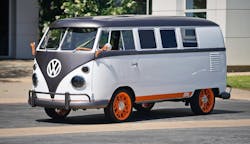Generative design is a type of software that allows engineers and designers to input their design goals, along with performance and/or spatial requirements, materials information, manufacturing methods, and cost constraints to create multiple design options. According to Autodesk, a supplier of design software, generative design technology is able to do this by testing and learning from each iteration what works and what doesn’t.
In a major application of this technology, Volkswagen Group unveiled a vintage VW Microbus retrofitted with several reconceptualized components created by generative design technology. VW is promoting this showcase vehicle to highlight technologies they feel will be significant to the future of automotive design and manufacturing, particularly with respect to electric vehicle production.
Autodesk collaborated with VW’s Innovation and Engineering Center California (IECC) on this project to maximize the strength of the vehicle while minimizing its weight. Generative design was employed for its ability to make lighter weight parts by minimizing mass and material use while maintaining high-performance standards and engineering constraints. Autodesk offers generative design capabilities as part of its Fusion 360 software.
Weight reduction is critical for electric vehicle efficiency as the less an automobile weighs, the less energy is required to propel it down the road. More efficient energy consumption equates to greater range per charge—one of the most important considerations for consumers when evaluating electric vehicles.
Vehicle weight reduction via generative design was first applied in this project to the wheels of the VW 1962 Type 2 11-window Microbus. Lighter wheels not only reduce the overall weight of the car, they also reduce rolling resistance on the tires. The new wheels created by the software are 18 percent lighter than a standard set and, with the help of the software, overall development time from design to manufacture was cut from 1.5 years to a few months.
“With generative design it’s possible to create structures that we, as human designers and engineers, could never have created otherwise,” said Andrew Morandi, senior product designer, Volkswagen Group. “One of the biggest surprises for me was seeing just how much material you could remove from a conventional wheel structure.”
Generative design was also used on the Microbus project to re-imagine the steering wheel, as well as the support structure for the rear bench seating and the external side mirror mounts.
“A steering wheel is not a particularly heavy component, but it’s the primary touchpoint for the driver,” said Erik Glaser, principal product designer, Volkswagen Group. “We wanted to put a generatively designed object in a place where people will touch it because, not only is it intricate and beautiful, but it can also give a sense of just how strong these parts can be.”
Looking ahead Morandi said, “I see this project as kind of dipping our toe in the water with generative design. I’m hopeful that in maybe 10 to 15 years we might see entire frames being generatively designed. It’s possible this could be part of a complete, fundamental change in automotive factories and how cars are manufactured.”
According to Autodesk, General Motors also used generative design earlier this year in a proof-of-concept project to develop a lightweight seat bracket prototype for its electric cars of the future. The technology is also proving its value for the future of space travel, Autodesk said, noting that last November NASA’s Jet Propulsion Laboratory unveiled a generatively designed interplanetary lander prototype that could conceivably carry payloads more than 350 million miles from Earth.

